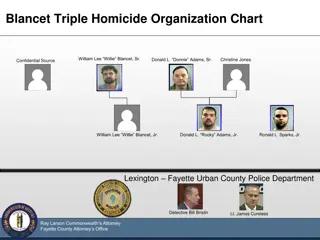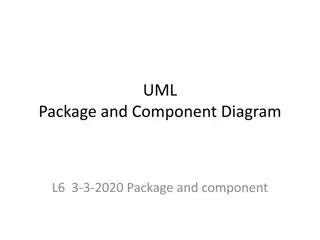Understanding Activity Diagrams and State Chart Diagrams
Activity diagrams describe the workflow behavior of a system by showing the sequence of activities performed, including conditional and parallel activities. Elements such as Initial Activity, Symbol Activity, Decisions, Signals, Concurrent Activities, and Final Activity are depicted in these diagrams. State Chart Diagrams, also known as state diagrams, show the sequence of states an object passes through in response to stimuli and messages. They are useful for analyzing and specifying the dynamic behavior of a system or individual classes.
Download Presentation

Please find below an Image/Link to download the presentation.
The content on the website is provided AS IS for your information and personal use only. It may not be sold, licensed, or shared on other websites without obtaining consent from the author. Download presentation by click this link. If you encounter any issues during the download, it is possible that the publisher has removed the file from their server.
E N D
Presentation Transcript
Activity Diagrams Activity diagrams describe the workflow behavior of a system. The diagrams describe the state of activities by showing the sequence of activities performed. Activity diagrams can show activities that are conditional or parallel.
When to Use: Activity Diagrams Activity Diagrams are also useful for: analyzing a use case by describing what actions need to take place and when they should occur; How to Draw: Activity Diagrams Activity diagrams show the flow of activities through the system. Diagrams are read from top to bottom and have branches and forks to describe conditions and parallel activities. A fork is used when multiple activities are occurring at the same time.
Elements of an Activity diagram Elements of an Activity diagram Element and its description Initial Activity: This shows the starting point or first activity of the flow. Denoted by a solid circle. This is similar to the notation used for Initial State. Symbol Activity: Represented by a rectangle with rounded (almost oval) edges. Decisions: Similar to flowcharts, a logic where a decision is to be made is depicted by a diamond, with the options written on either sides of the arrows emerging from the diamond, within box brackets. Signal: When an activity sends or receives a message, that activity is called a signal. Signals are of two types: Input signal (Message receiving activity) shown by a concave polygon and Output signal (Message sending activity) shown by a convex polygon.
Concurrent Activities: Some activities occur simultaneously or in parallel. Such activities are called concurrent activities. For example, listening to the lecturer and looking at the blackboard is a parallel activity. This is represented by a horizontal split (thick dark line) and the two concurrent activities next to each other, and the horizontal line again to show the end of the parallel activity. Final Activity: The end of the Activity diagram is shown by a bull's eye symbol, also called as a final activity.
activity diagram for processing an order activity diagram for processing an order
STATE CHART DIAGRAM Also called state diagram. Shows the sequence of states that an object goes through during its lifetime in response to outside stimuli and messages. During analysis, we use state diagram to indicate the dynamic behavior of the system During design, we use state diagram to specify dynamic behavior of individual classes or collaboration between the classes























